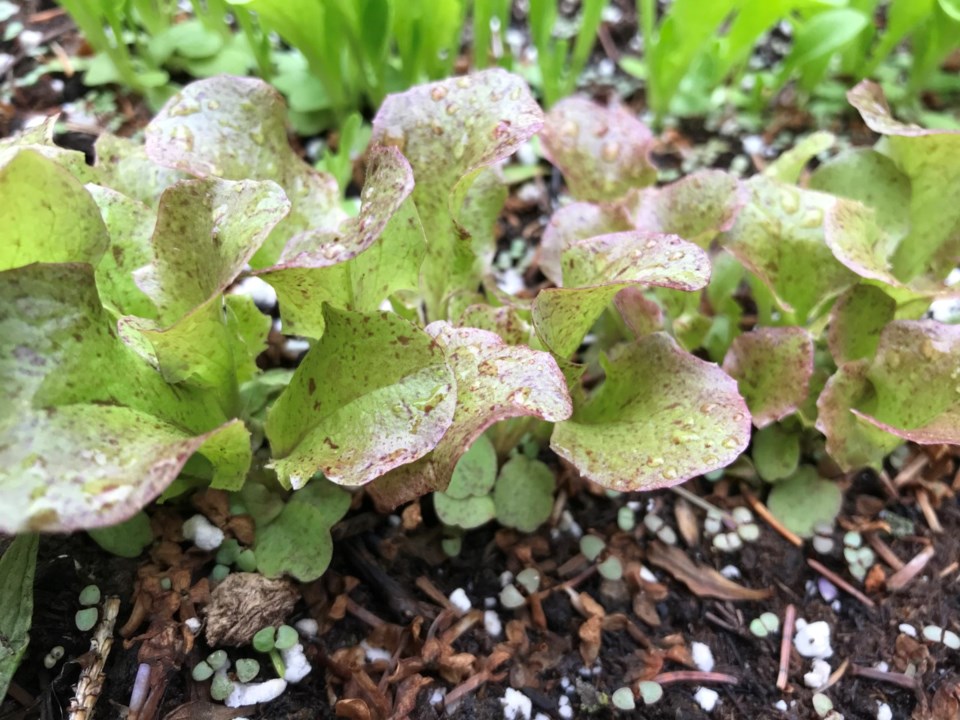Not all vegetables grow equally well. Some vegetables are more foolproof, more forgiving and just easier to grow than others. Following are some vegetables that new gardeners should try to gain self-confidence and achieve success.
Start your gardening season by sowing your spinach seed in early May. Spinach can withstand a few degrees of frost so there is no risk of killing plants in the event of a late spring frost. Sow seeds one to two centimetres apart within the row and one centimetre deep. Spinach rows should be a minimum of 30 centimetres apart. As the spinach emerges, thin plants to five centimetres between plants.
Beets, romaine lettuce, Swiss chard, peas, carrots, kale, kohlrabi and dill can all be directly seeded in mid-May. Like spinach, beets can be seeded very close together and then thinned to six to 10 centimetres between plants later in the season. Space between rows should be a minimum of 50 cm. Small beet seedling leaves are tasty in any salad. For your favourite recipe of beet leaves rolled with bread and dill sauce, try growing “Green Top Bunching”: recommended for its abundant leaves. Beetroots are ready to harvest as soon as their roots reach a reasonable size (2–10cm).
Of all the different types of lettuces to grow, romaine (cos) and leaf lettuce are the easiest in the northern garden. Like beets and spinach, lettuce can be sown densely and then thinned to 10cm spacing between plants within the row. The young lettuce plants that are thinned out provide excellent baby salad greens. Spacing between rows for lettuce should be 30 cm.
One of the easiest leafy vegetables to grow is Swiss chard. Space plants 2-3cm apart with a minimum of 30cm between rows. Plants are ready to harvest as soon as they reach a usable size (usually 20-30cm). Harvest Swiss chard by cutting stems at ground level. Plants will regrow throughout the season so that multiple harvests are possible.
Peas should be planted 1cm deep and 3-4cm between plants. Choose pea cultivars that are bred for resistance to powdery mildew and viruses. To minimize disease, ensure there is good air movement around pea plants (especially if they are not being supported with trellises or cages). Space pea rows at least 50cm apart.
Except for kale and kohlrabi, vegetables from the brassica/cabbage family are difficult to grow in the prairie garden due to severe insect and disease issues. Direct seed kale and kohlrabi in early spring. Both crops will survive several degrees of frost. Spring seeded kale can be ready to harvest as early as mid-July whereas kohlrabi stems are usually not harvested until mid or late July. Harvest kohlrabi stems that are 5-10cm in diameter.
If your garden has a rich sandy-loam soil, carrots will be an easy crop to grow. Seed carrot seeds in early-mid May, 1-2cm apart and 30cm between rows. Keep soil moist until carrot seedlings emerge. Seed carrots extra thick if irrigation will not be available. There are three main types of carrots available: imperator, Nantes and Danvers. Nantes types are the juiciest and best tasting.
As a new vegetable gardener, include potatoes in the garden. If the potato seed tubers are disease-free and healthy, potato plants will emerge and grow under some of the most stressful conditions. Potato tubers must have at least one viable sprout (or ‘eye)/piece. Plant potato pieces 10-15cm deep with at least 50cm between plants and rows. Potato yields will increase if you mound soil around the base of the potato plant (i.e. hilling) about 4 and 8 weeks after planting. New potatoes can be harvested as early as late July.
Green and yellow bush beans are easy vegetables to grow if they are seeded into warm soil: at least 15°C (usually late May in a northern garden). Cool soils tend to encourage seed rot and poor seedling vigour. Plant bean seeds 1-1.5cm deep, 3-4cm apart within the row. Rows should be spaced at least 30cm apart. Choose bean cultivars that have been bred with tolerance to common viruses.
Pumpkins are an easy, fun crop to include in your vegetable garden. Choose a cultivar that will mature in 90 days or less; pie pumpkins and smaller jack-o-lanterns are usually earlier maturing than larger cultivars. Seed the pumpkins directly into the soil after the third week in May. Allow 4m2 of space for each pumpkin plant.
Sow zucchini seed directly into the soil late in May; 2cm deep. Allow 1m2 for each plant. Zucchini plants can produce either yellow or green fruit. There is no difference in flavour however, the yellow fruit is much easier to see for harvesting than the green fruit.
Vegetable plants have limited root systems and require weekly water. Early in the season, water your garden every couple of days and less thoroughly while those tiny seeds are germinating. By mid-season, the veggie garden should be watered less frequently but more thoroughly, providing at least 2.5cm of water/week.
This column is provided courtesy of the Saskatchewan Perennial Society (SPS; [email protected]). Check our website (www.saskperennial.ca) or Facebook page (www.facebook.com/saskperennial) for a list of upcoming gardening events.




